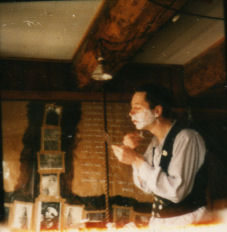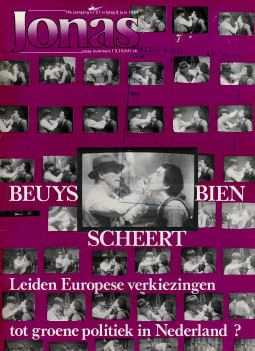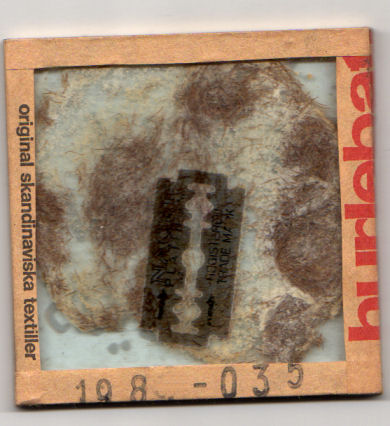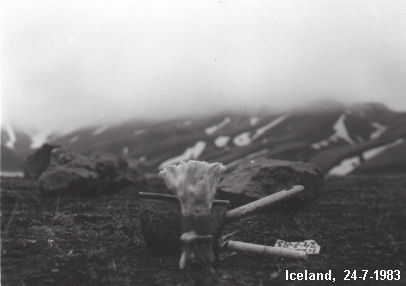|
|
 Regal Star, by Michiel Damen Regal Star, by Michiel Damen
Amsterdam, IJ harbor, 1983. The Greek mammoth freighter Regal Star is since several years waiting for cargo. With exception of three crewmembers the rusty ship seems deserted. Nevertheless, cargo Hold no 5 is still in use. A small manhole gives access. Forty steps count the ladder that leads from deck to below. A limited amount of sunlight penetrates the darkness through the half opened cargo hatch. The e normous space reminds of a cathedral. Every step sounds like a clock in a bell tower. The generator on deck is humming like a church organ. Construction beams become visible, reinforcing the ships hull. The floor is 25-x25 meter; rectangular steel plates welded together like tombstones of ancient sea hero’s. Than the eyes get used to the darkness. Although, the cargo hole is not completely empty. On the floor is the shine of a ring of glass plates visible. In the middle a man is standing, looking into a mirror. His face is soaped. He’s shaving himself. A staff with a shaving brush on top is leaning against a curious little table with bended metal feet and a stepped top. Water is warming up in a small saucepan on a gas cooker nearby. The last rests of soap in his face are washed away with it. The brush is cleaned and stowed away below a slate cover. The razor blade and shaving debris is then framed between two small glass plates and added to the ring on the ground. A lead scroll is rolled down to cover the mirror. With a steel pen written on it. What I describe are images of the video registration of Waldo Bien’s shaving project. normous space reminds of a cathedral. Every step sounds like a clock in a bell tower. The generator on deck is humming like a church organ. Construction beams become visible, reinforcing the ships hull. The floor is 25-x25 meter; rectangular steel plates welded together like tombstones of ancient sea hero’s. Than the eyes get used to the darkness. Although, the cargo hole is not completely empty. On the floor is the shine of a ring of glass plates visible. In the middle a man is standing, looking into a mirror. His face is soaped. He’s shaving himself. A staff with a shaving brush on top is leaning against a curious little table with bended metal feet and a stepped top. Water is warming up in a small saucepan on a gas cooker nearby. The last rests of soap in his face are washed away with it. The brush is cleaned and stowed away below a slate cover. The razor blade and shaving debris is then framed between two small glass plates and added to the ring on the ground. A lead scroll is rolled down to cover the mirror. With a steel pen written on it. What I describe are images of the video registration of Waldo Bien’s shaving project.
Bien’s work demands serious engagement and openness from the observer. Not every one us will straight away think of art when confronted with rusty bladder or the remnants of a simple shaving session. The shaving knives are normally thrown in the dustbin and the shaving debris washed away into the sewer. Bien’s work can’t be grasped with classical aesthetics. It includes thinking and holistic understanding. Like his teacher Joseph Beuys, with whom he studied 5 years, Bien’s art encloses life itself, shaking it awake, reforms it in a new and conscious way. Central in this understanding stands the knowledge of an existing  binding element, connecting all things that surround us. binding element, connecting all things that surround us.
“ In 1982 I was stuck with my work. My interdisciplinary research on the sculptural and intellectual problems around pedestal and frame had been going on since 1970, Raum 20, the Beuys class at the Academy, working with Michael Rutkowsky and Martin Schönenborn. One day, shaving in front of the mirror, I happen to look deep into my own eyes, for several minutes. I was shocked when I realised how little one knows about oneself. I saw deep unknown darkness. Not in the mirror, but within my self. ME. Our daily actions are ‘based’ on or coming out of this ‘unknown self’. They come out of it. I wanted to get to know this unknown self. The word ‘base’ has sculptural connotation. This was the doorway I had been searching for, the door that lead to the next level, the age long quest “to know oneself”, Delphi’s ephemeral underground domain. Everything one has stored so far, memories, habits, ideas and actions have to be questioned and reevaluated. Everything cleared and cleaned including corners. This notion came to me while I was shaving/ cleaning/clearing. Anthropological sculptural research has to be done to come to the right form of equipment. Tools had to be tailored to the process and the man. The work Black November (1982-005) is a sculptural report of my first tryout. I had started on the 1st November to shave in a process of self-reflection. The razor blade and debris I had decided to put between glass plates, old photographic slides that I had bought on the flea market. On the 12th of November I was in a traffic accident and ended up for several weeks in the hospital. The first thing I asked my wife Eliane, when I woke up there, was, to bring my shaving equipment and also a camera for self-observation. The rest of this one-month cycle found place in the hospital. In January 1983 I started a full year shaving project. The 365 glass plates with daily debris from 1983 would form a large circle on the ground, too big for my studio. In January 1983 I had found the right model for the shaving table. The process of self-initiation was translated into a ritual functional form, a functional toolkit. In the middle of the table a step pyramid (like Rutkowsky had built in Raum 20) had been installed with a slit running through, a fracture zone. That’s where the ax falls and the final decisions are taken. The stuff that is considered of no use for the future is dropped there, through this slit into the sewer. out of it. I wanted to get to know this unknown self. The word ‘base’ has sculptural connotation. This was the doorway I had been searching for, the door that lead to the next level, the age long quest “to know oneself”, Delphi’s ephemeral underground domain. Everything one has stored so far, memories, habits, ideas and actions have to be questioned and reevaluated. Everything cleared and cleaned including corners. This notion came to me while I was shaving/ cleaning/clearing. Anthropological sculptural research has to be done to come to the right form of equipment. Tools had to be tailored to the process and the man. The work Black November (1982-005) is a sculptural report of my first tryout. I had started on the 1st November to shave in a process of self-reflection. The razor blade and debris I had decided to put between glass plates, old photographic slides that I had bought on the flea market. On the 12th of November I was in a traffic accident and ended up for several weeks in the hospital. The first thing I asked my wife Eliane, when I woke up there, was, to bring my shaving equipment and also a camera for self-observation. The rest of this one-month cycle found place in the hospital. In January 1983 I started a full year shaving project. The 365 glass plates with daily debris from 1983 would form a large circle on the ground, too big for my studio. In January 1983 I had found the right model for the shaving table. The process of self-initiation was translated into a ritual functional form, a functional toolkit. In the middle of the table a step pyramid (like Rutkowsky had built in Raum 20) had been installed with a slit running through, a fracture zone. That’s where the ax falls and the final decisions are taken. The stuff that is considered of no use for the future is dropped there, through this slit into the sewer.
All personal ballast one has piled up has to be dealt with, judged, than either thrown overboard or stowed away in new context and value, as pedestal for the future. The self-judgment has a central function in the revaluation process. That should be visible in the form as well. “
M.D.: A mirror is attached to the shaving table and covered with a lead scroll. Isn’t that impractical?
The lead scroll has to be rolled up, like when a can of sardines is opened, to get access to the mirror. Rolling it up slows the process down, sharpens consciousness. Also, the hand is involved, a social instrument. The process is running through this hand. When I’m done I roll it down again, cover the mirror and scratch my journal notes in it with a steel pen.
 M.D.: Why did this shaving have to happen in the cargo hold of a ship? M.D.: Why did this shaving have to happen in the cargo hold of a ship?
I started in my studio Lauriergracht but I was running out of space. Also, I didn’t want this to find place between all other things that were going on. 1982/3 was an extremely active period with several large works in production.
So I thought about a place where I could continue this work undisturbed. Then I coincidentally met the Greek captain of the Regal Star, registered in Piraeus, and since years waiting in the Amsterdam harbour for cargo. The freight market had broken down, the ship was just too big. He showed us the ship, me and my friend Martijn van Haalen, a cameraman who later made the video registrations. The captain, his name was Janni Stopoulos, opened amidships Cargo Hold No 5 for us, to show how big it was. It was empty, perfect for what I had in mind. The captain generously offered me to use it for my project. I brought everything over and from then on visited each day by canoe or by boat, to shave. I worked there till the end of December. Shortly after the ship was loaded with scrap metal, sailed to Korea to be scrapped itself as well. Some of its iron plates where used to bind the five Regal Star books (1984-009, No. 1 Collection Caroline Tisdall). I had also built a portable shaving equipment to be used when was traveling. About one month of that year, 1983, I did fieldwork in Iceland. Those glass plates were later added to the circle. The little mirror that was part of my portable shaving unit, triggered an important photographic sequence, Nodlandroute (1983-008) and Psoriasis Trap (1983-002), where forward and backward become visible at the same time.
The Regal Star video shows one of his working visits to the ship, recorded by Martijn van Haalen with an old black and white camera, creating an intimate sphere. During the exhibition at Museum Boymans van Beuningen in Rotterdam, a filigree screen surrounded the video installation, as it seems to protect us against suggested radiation. On January the first, 1984, the project finds its Grand Final in Centre  Pompidou in Paris where Joseph Beuys, on his own initiative, shaves Waldo Bien. From New Delhi to New York this social sculptural action could be seen as part of the ‘live’ TV satellite program ‘Bonjour Mister Orwell’ under the public eye of Forty million onlookers. The broadcasted images, with artists like Salvador Dalí and composer John Cage participating, were mixed by the famous video artist Nam June Paik. It also marks the beginning of Waldo Bien’s ongoing engagement in the framework of the F.I.U. Amsterdam. In the life of Joseph Beuys this shaving in Paris was one of his last actions, the most public one. Nevertheless it has been deleted from his record. In his book “Joseph Beuys, Die Aktionen” published Stuttgart 1994, its author Uwe M. Schneede has listed this as one of the last actions of Beuys. Pompidou in Paris where Joseph Beuys, on his own initiative, shaves Waldo Bien. From New Delhi to New York this social sculptural action could be seen as part of the ‘live’ TV satellite program ‘Bonjour Mister Orwell’ under the public eye of Forty million onlookers. The broadcasted images, with artists like Salvador Dalí and composer John Cage participating, were mixed by the famous video artist Nam June Paik. It also marks the beginning of Waldo Bien’s ongoing engagement in the framework of the F.I.U. Amsterdam. In the life of Joseph Beuys this shaving in Paris was one of his last actions, the most public one. Nevertheless it has been deleted from his record. In his book “Joseph Beuys, Die Aktionen” published Stuttgart 1994, its author Uwe M. Schneede has listed this as one of the last actions of Beuys.
|
|